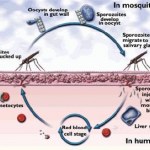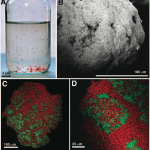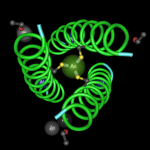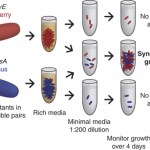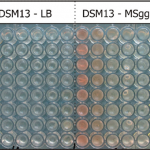bacteria
Researchers have actually trained a beagle named Cliff to detect the intestinal bacteria Clostridium difficile on patients and in stool samples that were collected from infected patients in the Netherlands. This infection is common in hospitals and long-term treatment facilities. Infection with the contagious C. diff results in diarrhea that has been responsible for the deaths of up to 14,000 Americans each year. Having a dog sniff out the infection may seem absurd until you consider it can take up to a week to detect the infection using traditional laboratory techniques. Being able…
Although Curiosity has not found evidence of life on Mars, NASA announced yesterday that its suite of dirt analyzers works perfectly. Meanwhile new discoveries on Earth and the planet Mercury continue to imply the possibility of extraterrestrial life. On ERV, Abbie Smith marvels at the extremophile bacteria that have been locked under an Antarctic ice sheet for the last 2800 years, "happily (but slowly!) generating proteins in their hypersaline, super cold, no oxygen, ton of iron environment!" And though Smith would love to work in Antarctica, she says it "might be more fun to go to Europa…
Even the best and brightest can get things wrong, which is why science depends on corroboration to get things right. On Respectful Insolence, Orac investigates the conviction of six Italian seismologists for failing to warn people about an earthquake that killed 300. Orac writes “‘earthquake swarms’ are not uncommon in the L’Aquila region” and “a medium-sized shock in a swarm forecasts a major event within several days only 2% of the time.” But for accurately assessing the risk of a major event, the government employees have been sentenced to six years in prison for manslaughter. On Starts…
Its like, instead of 'Put a bird on it!', scientists are like 'Put a virus on it!'
Got cancer? Put a virus on it! In constant pain? Put a virus on it! Addicted to cigarettes? Put a virus on it! Genetic disease? Put a virus on it!
Got acne? Put a virus on it!
Propionibacterium acnes Bacteriophages Display Limited Genetic Diversity and Broad Killing Activity against Bacterial Skin Isolates
YAY!!!
Acne, though not life-threatening, sucks.
If you dont have acne, consider yourself lucky. Some people can get it relatively under control with a combination of over the…
Life cycle of the malaria parasite. Image Source: Stanford University
Researchers, Jacobs-Lorena et al., at the Johns Hopkins Bloomberg School of Public Health have altered a harmless bacteria (Pantoea agglomerans) naturally found in the midgut of mosquitos to fight malaria by producing and releasing proteins that are toxic to malaria but harmless to mosquitos or humans. Since the gut is where the malaria parasite reproduces, this is the optimal location to put an end to it. The engineered bacteria were indeed successful at reducing the number of malaria oocysts by 98% in mosquitos with the…
With my colleague Greg Tinkler, I spent an afternoon last week at a local public library talking to kids about zombies:
The Zombie Apocalypse is coming. Will you be ready? University of Iowa epidemiologist Dr. Tara Smith will talk about how a zombie virus might spread and how you can prepare. Get a list of emergency supplies to go home and build your own zombie kit, just in case. Find out what to do when the zombies come from neuroscientist Dr. Greg Tinkler. As a last resort, if you can't beat them, join them. Disguise yourself as a zombie and chow down on brrraaaaiiins, then go home and…
A couple of weeks ago, I was horrified to learn of a new "biomed" treatment that has been apparently gaining popularity in autism circles. Actually, it's not just autism circles in which this treatment is being promoted. Before the "autism biomed" movement discovered it, this particular variety of "miracle cure" has been touted as a treatment for cancer, AIDS, hepatitis A,B and C, malaria, herpes, TB, and who knows what else. I'm referring to something called MMS, which stands for "miracle mineral solution." As I pointed out when I discovered its promotion for various maladies and then later…
On Tomorrow's Table, Pamela Ronald shares a breakthrough in the study of bacterial communication. Although bacteria have been known to use a limited chemical vocabulary, for the first time they have been observed to use a protein as a signalling mechanism. Ronald writes, "Ax21 is a small protein. It is made inside the bacterial cell, processed to generate a shorter signal and then secreted outside the bacterium." In the species studied, perception of Ax21 caused nearly 500 genes—ten percent of the bacterium's genome—to change expression. Thus galvanized, individual bacteria assemble into…
As I mentioned yesterday, the epidemiology of hemolytic uremic syndrome (HUS) was murky for several decades after it was first defined in the literature in 1955. In the ensuing decades, HUS was associated with a number of infectious agents, leading to the general belief that it was a "multifactorial disease"--one that had components of genetics and environment, much like we think of multiple sclerosis today, for example.
Several HUS outbreaks made people think twice about that assumption, and look deeper into a potential infectious cause. A 1966 paper documented the first identified outbreak…
...when it contains a weird gene conferring methicillin resistance that many tests miss.
Methicillin-resistant Staphylococcus aureus (MRSA) has become a big issue in the past 15 years or so, as it turned up outside of its old haunts (typically hospitals and other medical facilities) and started causing infections--sometimes very serious--in people who haven't been in a hospital before. Typically MRSA is diagnosed using basic old-school microbiology techniques: growing the bacteria on an agar plate, and then testing to see what antibiotics it's resistant to. This can be done in a number of…
One organism's trash is another organism's treasure. Our cellular wastes, carbon dioxide and water, nourish plants, which with added energy from sunlight produce the oxygen and sugars that we need to survive. At microscopic scales, these cycles of waste and food can get much more complicated, with many species of microbes working together to survive in harsh environments with limited nutrients.
When organisms (like us) digest sugars made of carbon (C), hydrogen (H), and oxygen (O), they split them up into carbon dioxide (CO2), hydrogen ions (H+) and high-energy electrons (e-) that were…
Synthetic biologists work on designing living cells, but engineered bacteria don't usually come up when you think of "designer" things. This year however, a synthetic biology design is up for a Brit Insurance Design of the Year award, up against the Lanvin Spring collection, Angry Birds, and Rock Band 3! Designers Daisy Ginsberg and James King worked in collaboration with the 2009 Cambridge iGEM team (including awesome blogger Lab Rat) to imagine ways that people could use bacteria engineered to produce pigments in the future. Check out their video about the science and design of E. chromi:
The Harvard Microbial Sciences Initiative Graduate Consortium hosted a fun workshop during the January term where students learned about microscopy by taking some amazing pictures of food microbes. The images taken with the scanning electron microscope of sauerkraut, kombucha, and some stinky cheeses show beautiful and complex landscapes made by and of microbes.
Sauerkraut is fermented by cute rod-shaped lactic acid bacteria:
Kombucha, a tea fermented by a combination of yeasts and bacteria, looks incredible under the microscope, where you can see the dense mesh of cellulose fibers that the…
My friend Patrick is embarking on a 48 experiment, studying circadian rhythm and destroying his own in the process. He's also embarking on a social media experiment, live-streaming the whole thing on ustream.
Tune in to watch real science in action and the effects of sleep deprivation on scientists! You can even ask him questions during the three hours between experimental time points!
It's been interesting to watch as microbiology's own cold fusion debate has been raging. It began with an extraordinary claim about bacteria using arsenate as a replacement when phosphate concentrations are low (1).
It progressed when at least two scientist / bloggers ( here, and here) (not bloggers! the horrror! how uncivil!) gave public "journal club" presentations on blogs (envision dripping slime).
It continued with the science journalists lamenting about having swallowed the hype.
And it seemingly ended with another scientist / blogger's post that seemed to equate discussions…
It's been a few weeks since the iGEM jamboree, a whirlwind, completely exhausting weekend of student synthetic biology projects. This tweet from Robin Sloan from the #igem2010 stream is a pretty good way to sum up the weekend:
.bbpBox987719207489536 {background:url(http://a3.twimg.com/profile_background_images/3386569/giant2.jpg) #777f88;padding:20px;} p.bbpTweet{background:#fff;padding:10px 12px 10px 12px;margin:0;min-height:48px;color:#000;font-size:18px !important;line-height:22px;-moz-border-radius:5px;-webkit-border-radius:5px} p.bbpTweet span.metadata{display:block;width:100%;clear:…
This year's Cambridge iGEM team has made a tiny, wireless lightbulb filled with bioluminescent bacteria! There are two main ways of engineering luminescence in E. coli (I assume these are E. coli, correct me if I'm wrong!). One is to express the luciferase gene from fireflies, which adds ATP and oxygen to the chemical luciferin, producing oxyluciferin and yellow, green, or red light.
Since the lightbulb is blue, this bacteria is probably expressing the Lux operon from Vibrio fischeri, which use their bioluminescence in an awesome underwater symbiosis. From the Cambridge iGEM wiki:
Some…
My good friend and labmate just published an awesome paper: "Emergent cooperation in microbial metabolism." His experiment started with 46 strains of E. coli that had mutations in their metabolic pathways that prevented them from being able to grow without supplementing the media with extra metabolites. Alone they died, but grown together in the same tube, many pairs of mutants were able to feed each other the missing metabolite. Metabolic cooperation was the key to survival.
Measuring and understanding metabolic cooperation can be used to build stronger, more predictive models of…
Cells are constantly jibber jabbering, sending messages to each other to coordinate behavior, both within a population of single-celled organisms or between cells of an individual multicellular organism. Most of these signals are chemicals that float around in the liquid that surrounds the cells but there recently has been an increased appreciation for cells' sense of "smell"--how cells respond to chemicals that are present as gasses.
A brand new paper outlines the discovery of "olfaction" in a species of bacteria, Bacillus licheniformis. Trying to save space on a 96 well dish by putting…
Life transforms environments, creating ecosystems where there was once only rocks. The evolution of photosynthetic bacteria billions of years ago created the atmosphere we have today, paving the way for the evolution of larger, oxygen-breathing organisms. We humans obviously transform our environment in countless ways, but can we also engineer barren environments to be hospitable to life? Can we create new living, self-sustaining ecosystems in hostile places? Can we turn lifeless planets into second Earths through the clever introduction of life forms?
Terraforming is the (currently…
